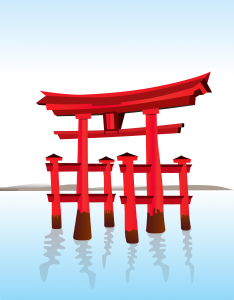Shinto in Japan
Seamus Cullen, Columban priest, Japan
 Columbans encounter adherents of the Shinto religion in Japan, where it is largely confined.
Columbans encounter adherents of the Shinto religion in Japan, where it is largely confined.
Shinto is the largest religion in Japan, practiced by nearly 80% of the population, yet only a small percentage of these identify themselves as “Shintoists” in surveys. This is due to the fact that “Shinto” has different meanings in Japan: most of the Japanese attend Shinto shrines and beseech “kami” without belonging to an institutional “Shinto” religion. And since there are no formal rituals to become a member of folk Shinto, “Shinto membership” is often estimated by counting those who join organised Shinto sects. Shinto has 100,000 shrines and 20,000 priests in the country.
The word Shinto (“way of the gods”) was adopted, originally as Shindo, from the written Chinese Shendao (神道, pinyin: shéndào), combining two kanji: “shin” (神), meaning “spirit” or kami; and “tō” (道), (This “to” or “doh” has the same meaning as the “doh” in Judo or Aikido or Shodo (Calligraphy) meaning a philosophical path or study (from the Chinese word dào). The oldest recorded usage of the word Shindo is from the second half of the 6th century. Kami are defined in English as “spirits”, “essences” or “gods”, referring to the energy generating the phenomena. Since Japanese language does not distinguish between singular and plural, kami refers to the divinity, or sacred essence, that manifests in multiple forms: rocks, trees, rivers, animals, places, and even people can be said to possess the nature of kami. Kami and people are not separate; they exist within the same world and share its interrelated complexity.
At an Interfaith Conference, which has continued for forty eight years here in Japan (I’ve been attending for the last ten years or so) I met a man who is perhaps the leading expert on Shinto in Japan. It was he who told me something which perhaps is the simplest indication of what is basic to Shintoism. He talked about the word “kami” which we use to mean “god”. This Chinese character 神 is made up of two elements. The element on the left originally looked like 示。When it first came from China the two slanting lines were broken lines and indicated the blood dripping from the sacrificial altar. The shorter horizontal line was the sacrifice lying on the altar, the longer horizontal line. The element on the right of the character gradually developed into its present shape from an icon that was easier to identify as lightning as seen in a thunder and lightning storm. This “lightning” element indicated the feeling of fear. The two elements put together describe the awareness that arises in the person who has had a “god” experience. That experience generates in the person a desire to “worship” but also a feeling of fear. So the word “kami” is not really saying anything about god. It is describing the awareness of the human being in the face of the god reality.
There is a theological grounding given for our own instinctual yearning for a faith that resonates with our own “matter”– the natural world. While on the one hand it would seem that Shintoism is finding god in every reality, a better understanding would be that because the god reality cannot be expressed in words, the felt awareness of his/her omnipresence is indicated by the word kami. The deep-seated awareness of, and attention to, the detail of things, the popularity of the “haiku” form of poetry which captures this detail, come, I have no doubt from the sensitivity towards the sacredness of everything that is the Shinto heart. I used the word “capture” just now so I hasten to qualify. The essence of the haiku is that it does not attempt to capture the reality of which it speaks. It points towards it and “those who have eyes to see will see”.
The most important aspect of the Shinto reality in Japan is the underlying mind-set. It is the mind-set which sees all things as being sacred. It is the deep-seated diffidence towards nature and natural phenomena. This is reflected in the title of a book written by a doctor who lived in the Fukushima area affected by the natural and man-made disasters a couple of years ago. The book is called “We Don’t Ask Why”. For a missionary like me here in Japan I find this reverence towards the “unknown” a delightful environment in which to share my awareness of God.
Most Japanese do not exclusively identify themselves as adherents of a single religion; rather, they incorporate elements of various religions in a syncretic fashion known as Shinbutsushūgō (神仏習合 amalgamation of kami and buddhas. ShinbutsuShūgō officially ended with the Shinto and Buddhism Separation Order of 1886, but continues in practice. Shinto and Japanese Buddhism are therefore best understood not as two completely separate and competing faiths, but rather as a single, rather complex religious system.
(Scheid, Bernhard. “Religion in Japan“– Hauptseite, University of Vienna)
It is for this kind of reason, namely, that Shintoism and Buddhism go well together in Japan that I would stress that for the missionary the importance of the contemplative approach to “spiritual” reality must be emphasised. The “doctrinal” approach tends to isolate people from each other and from society at large.
